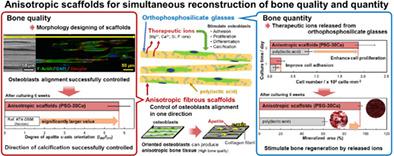当前位置:
X-MOL 学术
›
J. Biomed. Mater. Res. Part A
›
论文详情
Our official English website, www.x-mol.net, welcomes your feedback! (Note: you will need to create a separate account there.)
Development of orthophosphosilicate glass/poly(lactic acid) composite anisotropic scaffolds for simultaneous reconstruction of bone quality and quantity
Journal of Biomedical Materials Research Part A ( IF 4.9 ) Pub Date : 2020-07-27 , DOI: 10.1002/jbm.a.37067 Sungho Lee 1, 2 , Fukue Nagata 1 , Katsuya Kato 1 , Toshihiro Kasuga 3 , Takayoshi Nakano 2
Journal of Biomedical Materials Research Part A ( IF 4.9 ) Pub Date : 2020-07-27 , DOI: 10.1002/jbm.a.37067 Sungho Lee 1, 2 , Fukue Nagata 1 , Katsuya Kato 1 , Toshihiro Kasuga 3 , Takayoshi Nakano 2
Affiliation

|
Reconstruction of organ‐specific architecture is necessary to recover the original organ function. The anisotropic structure of bone tissue is strongly related to the collagen fibril alignment and bone apatite crystal direction. Bone regeneration indicates following two main process; first, restoration of bone mineral density (BMD; bone quantity), and second, restoring bone apatite c‐axis orientation (bone quality). In addition to BMD, bone quality is the most important factor among bone mechanical properties. Recovery of the original bone function requires development of novel scaffolds with simultaneous reconstruction of bone quality and quantity. Herein, novel orthophosphosilicate glass (PSG)/poly(lactic acid) composite anisotropic scaffolds were developed to control cell alignment and enhance bone formation, which are important for the simultaneous reconstruction of bone quality and quantity. The strategy to control cell alignment and bone formation involved designing anisotropic scaffolds in combination with the release of therapeutic ions by PSGs. The morphology of fibrous scaffolds containing PSGs was quantitatively designed using electrospinning. This successfully modulated cell alignment and subsequent bone apatite c‐axis orientation along the fiber‐oriented direction. The released silicate and Mg2+ ions from PSGs in scaffolds improved cell adhesion, proliferation, and calcification. To best of our knowledge, this is the first report demonstrating that the anisotropic scaffolds containing bioactive glasses regenerate bone tissues with simultaneous reconstruction of bone quality and quantity via stimulating osteoblasts by inorganic ions and designing morphology of scaffolds.
中文翻译:

用于同时重建骨质量和数量的正磷硅酸盐玻璃/聚(乳酸)复合各向异性支架的开发
器官特异性结构的重建对于恢复原始器官功能是必要的。骨组织的各向异性结构与胶原纤维排列和骨磷灰石晶体方向密切相关。骨再生指以下两个主要过程;一是恢复骨矿物质密度(BMD;骨量),二是恢复骨磷灰石c轴方向(骨骼质量)。除了 BMD,骨质量是骨力学性能中最重要的因素。恢复原始骨功能需要开发新型支架,同时重建骨质量和数量。在此,开发了新型正磷酸硅酸盐玻璃(PSG)/聚(乳酸)复合各向异性支架来控制细胞排列和增强骨形成,这对于同时重建骨质量和数量非常重要。控制细胞排列和骨形成的策略包括设计各向异性支架并结合 PSG 释放治疗性离子。使用静电纺丝定量设计含有 PSG 的纤维支架的形态。这成功地调节了细胞排列和随后的骨磷灰石c轴取向沿纤维取向方向。支架中 PSG释放的硅酸盐和 Mg 2+离子改善了细胞粘附、增殖和钙化。据我们所知,这是第一份证明含有生物活性玻璃的各向异性支架通过无机离子刺激成骨细胞和设计支架形态来再生骨组织,同时重建骨质量和数量的报告。
更新日期:2020-07-27
中文翻译:

用于同时重建骨质量和数量的正磷硅酸盐玻璃/聚(乳酸)复合各向异性支架的开发
器官特异性结构的重建对于恢复原始器官功能是必要的。骨组织的各向异性结构与胶原纤维排列和骨磷灰石晶体方向密切相关。骨再生指以下两个主要过程;一是恢复骨矿物质密度(BMD;骨量),二是恢复骨磷灰石c轴方向(骨骼质量)。除了 BMD,骨质量是骨力学性能中最重要的因素。恢复原始骨功能需要开发新型支架,同时重建骨质量和数量。在此,开发了新型正磷酸硅酸盐玻璃(PSG)/聚(乳酸)复合各向异性支架来控制细胞排列和增强骨形成,这对于同时重建骨质量和数量非常重要。控制细胞排列和骨形成的策略包括设计各向异性支架并结合 PSG 释放治疗性离子。使用静电纺丝定量设计含有 PSG 的纤维支架的形态。这成功地调节了细胞排列和随后的骨磷灰石c轴取向沿纤维取向方向。支架中 PSG释放的硅酸盐和 Mg 2+离子改善了细胞粘附、增殖和钙化。据我们所知,这是第一份证明含有生物活性玻璃的各向异性支架通过无机离子刺激成骨细胞和设计支架形态来再生骨组织,同时重建骨质量和数量的报告。



























 京公网安备 11010802027423号
京公网安备 11010802027423号